
Studio teaching
A key element of the Wood Be Better research project has been the six consecutive master level studio courses set up as laboratories for systematic architectural exploration. The research intention of the courses was described in the original project proposal:
“The studio courses will produce a series of integrated designs that will explore the effects of wood application on the functional, technical and architectural quality of whole buildings and areas. This is not possible in ordinary research projects because it will be too expensive or too slow. It also represents a type of architectural research that utilises the core competence of architects. This is to structure and transform large amounts of data and complex sets of requirements into integrated architectural solutions.”
The studio projects and tasks were located in the rapidly urbanising areas of Oslo and Akershus. The sites were typically in close proximity to AHO and therefore natural objects of study. Typical urban sites were chosen, such as infills or extensions within the existing city centre, developments at traffic nodes and densification in areas presently dominated by single-family houses. Two to eight storey structures became the focus of the studios as this is expected to be a dominant building category in the future timber city.
The courses offered teaching in both silviculture and the properties of wood as a material, used in new types of timber products and constructions. The pedagogical intention was to expose students to big and complex building design tasks on difficult urban sites, challenging them to carry out designs that were convincing both in architectural quality and technological resolution. In addition the students were guided by an interdisciplinary team of lecturers and studio tutors, at a level not usual in master studios. By showing timber solutions integrated in the design of whole buildings the student projects could verify the potentials of new technologies.
In essence, the courses were built on the hypothesis that by maintaining a focus on realistic and complex applications of timber solutions, it was possible to produce student projects that could contribute to an illustration of the characteristics of a new timber city.
Technical advisors and tutors have included: Nils Forsén (structure and fire), Sigurd Eide (structure), Odd Grøthe (structure), Pål Cappelen (structure and fire), Arnkell J. Petersen (climatisation) and Lars V. Strand (acoustics).
A closer description and discussion of the courses are given in this article:
Teaching Timber: The role of architectural students and studio courses within an interdisciplinary research project (PDF)
Low-rise high-density prefabricated timber housing
AUTUMN 2016
Course description:
As Oslo’s urban planning for the coming decades is based on densification, a broader range of typologies than traditional blocks of flats and single-family houses needs to be considered. Low-rise high-density housing with 3 to 4 floors could fill this gap and will be the topic of this course. In the context of increasing focus on a building’s environmental impact, timber as a construction material is of great relevance. Additionally, new building codes and updated production methods enable an extended use of timber in urban areas. We are going to explore the opportunities that prefabricated timber solutions can offer to low-rise high-density housing. The project development will span from a conceptual approach via an urban strategy to an architectural project with technical solutions and key details. Collaboration with OBOS, lectures by various experts and reviews by recognized architects will contribute to the learning results and to a practice-oriented framework in the studio. The course is integrated in Ute Groba's Phd project.
For further background, aims and results of the course are described in this report:
Titel, titel, link
Tutors: Ute Groba, Sissil Gromholt, Marius Nygaard (Colm O’Brien, Lars Hamran)
Students: Prommanas Amatayakul, Jon Erik Dybedal Brekken, Marie Krafft Bruland, Kaja Strand Ellingsen, Sigurd Nøsterud, Ingri Heggebø, Mina-Matilde Håøya, Edward Gunnar Nesse, Oda Frøyen Nybø, Marius Hauland Næss, Helene Offer-Ohlsen, Ragnhild E Osbak, Dag Ulrik Pettersen, Ingeborg G Svalheim, Silje Træen, Ragnhild Marie C Østern
External examiner: Minna Riska, MDH Arkitekter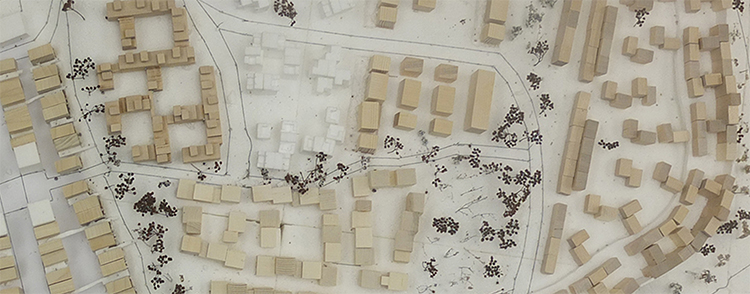
Selected student projects:
 MORTENSRUD ENG - by Marie Krafft Bruland and Kaja Strand Ellingsen
MORTENSRUD ENG - by Marie Krafft Bruland and Kaja Strand Ellingsen
The project creates a neighbourhood with connections both
to the surrounding situation and within itself to create smaller, social communities. The project uses a combination of CLT and gluleam beam and column system on the first floor and a gluelam beam and column structure on the second floor
DOWNLOAD PROJECT DESCRIPTION HERE (pdf)
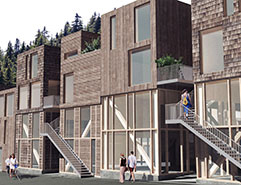 MORTENSRUD URBAN BELT - by Oda Frøyen Nybø and Ingeborg Svalheim
MORTENSRUD URBAN BELT - by Oda Frøyen Nybø and Ingeborg Svalheim
The project combines public and residential functions in a 4floor volume. The upper two floors are primarily residential and the lower floors make up a flexible volume that can be adapted for public functions or residential units according to need. The project combines systems of CLT and glulam post and beam frameworks.
DOWNLOAD PROJECT DESCRIPTION HERE (pdf)
 PEGGED IN POSTS AND PILLARS - by Marius Hauland Næss and Sigurd Strøm Nørsterud
PEGGED IN POSTS AND PILLARS - by Marius Hauland Næss and Sigurd Strøm Nørsterud
The housing units in this project explore a modular concept of living in vertically stacked spaces. The construction consists of 16 columns in a grid of four 3x3m areas spaced 1m apart. The load bearing columns allows flexibility in the vertical positioning of slabs, providing clear boundaries between spaces and a variety of ceiling heights.
DOWNLOAD PROJECT DESCRIPTION HERE (pdf)
To order high resolution of project descriptions:
The above project descriptions have been reduced in size for ease of upload and accessibility. This may in some cases have affected the overall quality and resolution of images or drawings. You can request high resolution copies of the original documents by contacting the WBB using the email wbb@aho.no. Please stipulate the title of desired project and intended purpose and/or use of project material.
Forest-Timber-Public Building
SPRING 2016
Course description:
Through the design of a medium-sized public building in timber, the course will examine opportunities for better utilization of timber as a building material. The assignment was a library including an amphitheater and and stage in the town centre of Spydeberg. The course is part of the research project Wood Be Better and will provide a solid knowledge base for using timber in a new, multifunctional urban building. We will meet representatives from the entire product chain; forestry, wood industry, retailers, developers and contractors.
Tutors: Børre Skodvin, Lars Hamran
Students: Jonatan Angell-Ramberg, Gine Backer-Røed, Kaia Kristine Giltun, Truls Glesne, Morten Jakobsen, Daniel Aarset Loe, Jon Bjørn Dundas Morå, Dag Ulrik Pettersen, Erik Reiten, Michelle Schneider, Elin Schnipper, Synnøve Solberg, Benjamin Velure, Anna Willemark
External examiner: Kaja Poulson, MoPo arkitekter
Selected student projects:
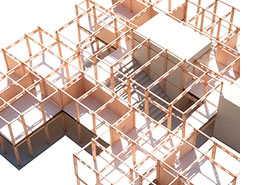 Spydeberg Library - by Anne Willemark and Synnøve Solberg
Spydeberg Library - by Anne Willemark and Synnøve SolbergThe main structure is a post and beam system in which the wooden columns are split into bundles of four members that are connected by stiffeners. The flexible book shelves in the library rest on these stiffeners. The timber beams are also split into parallel chords with wooden stiffeners. The structural system has a transparent character that allows daylight into the library and creates spatial and visual continuity.
DOWNLOAD PROJECT DESCRIPTION HERE (pdf)
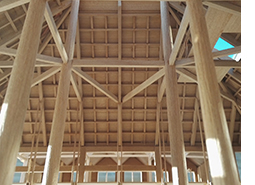 SPYDEBERGSMIA - Jon Bjørn Dundas Morå og Daniel Aarset Loe
SPYDEBERGSMIA - Jon Bjørn Dundas Morå og Daniel Aarset Loe
The library is at the core of this new cultural and community centers in Spydeberg. The building provide a number of different spacial alternatives for groups that may want to use the building in different ways. Including a lookout tower, a workshop, various meeting rooms and venues.
DOWNLOAD PROJECT DESCRIPTION HERE (pdf)
 THE LIBRARY AT SPYDEBERG - by Benjamin Alstrup Velure, Dag Ulrik Pettersen, Truls Glesne
THE LIBRARY AT SPYDEBERG - by Benjamin Alstrup Velure, Dag Ulrik Pettersen, Truls GlesneThe project consists of three main volumes with different characteristics. The open ground floor plan is an extension of the surrounding urban spaces. The central amphitheater is located at the heart of the building. The cantilevered floor slabs are suspended from beams supported by vertical and diagonal columns.
DOWNLOAD PROJECT DESCRIPTION HERE (pdf)
To order high resolution of project descriptions:
The above project descriptions have been reduced in size for ease of upload and accessibility. This may in some cases have affected the overall quality and resolution of images or drawings. You can request high resolution copies of the original documents by contacting the WBB using the email wbb@aho.no. Please stipulate the title of desired project and intended purpose and/or use of project material.
Urban transformation in timber
AUTUMN 2015
Course description:
Sustainable buildings must be designed for long life cycles. They must have a high and durable architectural and technical quality and they must be adaptable to varied use over time. They must combine generality in room forms with possibilities for flexible partitioning and furnishing. This requires tight coordination of constructions, building envelopes and the systems for water supply, sewage, heating and ventilation.
The main aim of the course is to develop strategies for transformations in dense, urban locations using timber as a main material. The design task is a medium-sized project combining new buildings, add-ons and refurbishment. The project shall contain a mixture of dwellings and other functions typical of urban areas. Adaptability to alternate future use shall be explored and documented.
The formability of timber components shall be utilized in studies of how contrasting geometries may interact in architectural design. The solutions shall be developed to a high degree of detail. Selected site: Maridalsveien 10.
Tutors: Marius Nygaard, Catherine Sunter, Lars Hamran
Students: Ingri Heggebø, Sunniva Nordli Helseth, Johanne Finanger Killi, Ida Helene Holm Mjelde, Pål Andreas Løyning, Jan Kazimierz Godzimirski, Maria Årthun, Sigurd Aune Hellem, Anja Lauvli Schley, Michelle Schneider, Synnøve Solberg, João Carlos da Silva Mendes, Léa Guillot, Joana Alexandra Agra Graça, Roel Hofstra
External examiners: Christopher Adams, partner in div.A architects
Selected student projects: 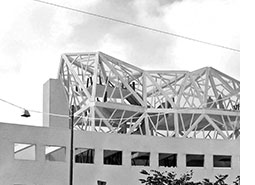 THE BOTANICAL LEARNING CENTRE - by Roel Hofstra
THE BOTANICAL LEARNING CENTRE - by Roel Hofstra
A new wooden greenhouse is added onto the existing building. The greenhouse is constructed as an irregular skeleton. The floors are made of cross-laminated timber (CLT), carried by the existing concrete structure. The triangulated construction system adapts easily to different shapes, enabling the structure to respond to the building below and to its surroundings.
DOWNLOAD PROJECT DESCRIPTION HERE (pdf) HOSTEL - by Sunniva Helseth, Johanne Killi and Anja L Schley
HOSTEL - by Sunniva Helseth, Johanne Killi and Anja L Schley
The project responds to the historic and environmental conditions of the site. The hostel offers 168 beds and common functions that bring activity to the area. The main structural system is cross laminated timber walls and floor slabs together with glulam beams. The shear stiffness of the curved CLT walls stabalise the structure.
DOWNLOAD PROJECT DESCRIPTION HERE (pdf)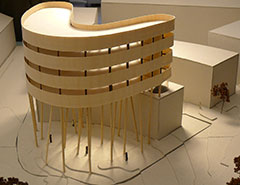 FLOATING WOODEN OFFICE - by Ingri Heggebø and Synnøve Solberg
FLOATING WOODEN OFFICE - by Ingri Heggebø and Synnøve Solberg
The new building is elevated 15 meters off the ground and follows the curved outlines of the site, hovering above the existing building. The primary construction consists of a system of glulam colums and beams. The building rests on 22 steel columns. At least two columns support each radial beam in the floor construction.
DOWNLOAD PROJECT DESCRIPTION HERE (pdf)
To order high resolution of project descriptions:
The above project descriptions have been reduced in size for ease of upload and accessibility. This may in some cases have affected the overall quality and resolution of images or drawings. You can request high resolution copies of the original documents by contacting the WBB using the email wbb@aho.no. Please stipulate the title of desired project and intended purpose and/or use of project material.
Forest-Timber-Suburban Housing
SPRING 2015
Course description:
Through the studio assignment, the course will examine opportunities for better utilization of timber. The course will have focus on the cultivating, sourcing and processing timber products. As part of this the students will select and cut trees from the forest first hand. The selection may comprise a number of species including spruce and pine, as aspen, ash, oak, birch, elm, etc. We will emphasize what the timber will be used for when we decide what to cut and how to saw it. The logging and sawing will be carried out in cooperation with Svenneby sawmill. The students will be offered training in the use the chainsaw and protective equipment. The design assignments will be oriented towards material quality and structural potential and must be accompanied by a model study in which a segment / detail of the building is shown in large scale.
A more indepth description of the course and a collection of course work is available in this booklet:
SKOG-TRE-BYGG villafortetting i Oslo (pdf)
Tutors: Børre Skodvin, Lars Hamran
Students: Kristian Refshal Vea, Eskil Frøyen Nybø, Shohreh Kheirati, Åsa Maria Elisabet Johansson, Gustav Mattias Jitzhak Tellqvist, Ona Katrina Flindall, Gro Krüger, Nora Ingeborg H Mørch, Halvor André H Saga, Eirik Stiansen, Siri Idland, Signe Henriette Ludvigsen, Kamilla Merete Kristiansen, Ole Fredrik Kleivene, Haris Ramic
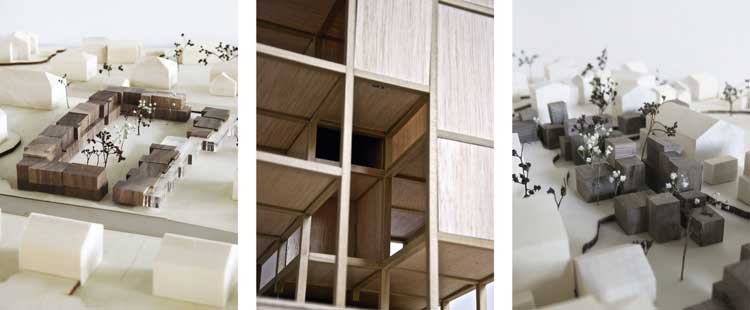
Selected student projects:
 WOODEN JOINERY HOUSE - by Kamilla Merete Kristiansen
WOODEN JOINERY HOUSE - by Kamilla Merete KristiansenThe project proposes densification of an existing residential area at Grefsen, Oslo. The wooden structure of the housing project is based on a old japanese joinery system, where columns meet beams in a fourfold joint. The system requires no metal fasteners, and appears as a continuous structural grid with a clean look.
DOWNLOAD PROJECT DESCRIPTION HERE (pdf)
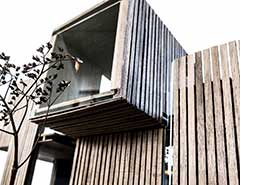 IN-BETWEEN - by Shohreh Kheirati
IN-BETWEEN - by Shohreh KheiratiThe concept is built upon reusing the spaces in between the existing houses, with are today used as big gardens. The project has open rooms towards the road and the exiting houses so that the new houses have good view to the surrounding. In order to maintain the privacy between the new houses, the facade is more closed in between the new volumes.
DOWNLOAD PROJECT DESCRIPTION HERE (pdf)
 9 IN TIMBER - by Eskil Frøyen Nybø
9 IN TIMBER - by Eskil Frøyen NybøInstead of the conventional stacking of floor-height walls this CLT structure consists of half-height elements that are assembled as a CLT "log" construction. This breaks up the typical spatial division of the terraced house. Openness and visual connections are created between rooms and between the main facades.
DOWNLOAD PROJECT DESCRIPTION HERE (pdf)
To order high resolution of project descriptions:
The above project descriptions have been reduced in size for ease of upload and accessibility. This may in some cases have affected the overall quality and resolution of images or drawings. You can request high resolution copies of the original documents by contacting the WBB using the email wbb@aho.no. Please stipulate the title of desired project and intended purpose and/or use of project material.
An adaptable urban timber building
AUTUMN 2014
Course description:
The main aim of the course is to develop strategies for adaptable urban timber buildings. The design task is a medium-sized office building containing workplaces, conference rooms, exhibition/information areas, cafeteria and restrooms/wardrobes. Adaptability to alternate future work patterns, user groups or functions shall be documented. The formability of timber components shall be utilized in studies of how contrasting geometries may interact in architectural design. An infill site in the Grünerløkka area in Oslo was chosen as location for the project.
Tutors: Marius Nygaard, Lars Hamran, (Ute Groba)
Students: Kristian Refshal Vea, Erik Ohnstad Folmo, Jon Kåre Mannsåker, Anja Hole, Marte Guldvik, Eskil Frøyen Nybø, Katrine Hamre Sørlie, Truls Schiefloe Sandbakk, Even Småkasin, Stine Kornmo Janssen, Gro Krüger, Eirik Stiansen, Thomas Johannessen, Eline Egeland, Ingrid Engøy Henriksen, Ole Fredrik Kleivene
External examiner: Todd Saunders, Saunders Architecture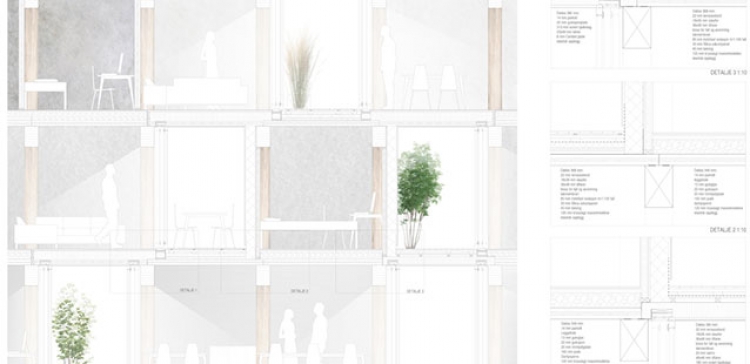
 NORDRE GATE 20/22 - by Ingrid Engøy Henriksen and Katrine Hamre Sørlie
NORDRE GATE 20/22 - by Ingrid Engøy Henriksen and Katrine Hamre SørlieThe project is an organically shaped urban block. A duble glulam frame system allows easy adaption both to the existing buildings and the complex new volumes. It is designed for flexible subdivisions while still being exposed to the interior. Externally shingel cladding is combined with a varied and elegant window system.
DOWNLOAD PROJECT DESCRIPTION HERE (pdf)
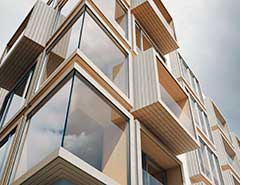 A TIMBER BUILDING KIT - by Even Småkasin og Eskil Frøyen Nybø
A TIMBER BUILDING KIT - by Even Småkasin og Eskil Frøyen NybøA regular building volume is effortlessly integrated in the urban block structure. The internally exposed glulam skeleton allows rapid and optimal adaption to different functions during the building´s life time. Together with specially designed wooden interior furnishings a system of timber boxes creates variety both in the interior and the exterior of the building.
DOWNLOAD PROJECT DESCRIPTION HERE (pdf)
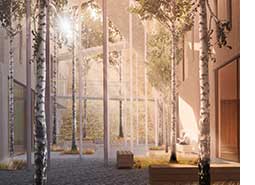 AN ADJUSTABLE URBAN TIMBER BUILDING - by Marthe Guldvik, Ole Fredrik Kleivene and Gro Krüger
AN ADJUSTABLE URBAN TIMBER BUILDING - by Marthe Guldvik, Ole Fredrik Kleivene and Gro KrügerComprehensive site analyses and solar studies resulted in a stepped volumetric solution. Innovation is also shown by combining timber cassette floor elements (Lignatur, Switzerland) that allow free spans and free plans. The loadbearing external walls are stacked and joined in a way that also provides lateral stability of the building.
DOWNLOAD PROJECT DESCRIPTION HERE (pdf)
To order high resolution of project descriptions:
The above project descriptions have been reduced in size for ease of upload and accessibility. This may in some cases have affected the overall quality and resolution of images or drawings. You can request high resolution copies of the original documents by contacting the WBB using the email wbb@aho.no. Please stipulate the title of desired project and intended purpose and/or use of project material.
Urban housing in wood - Possibilities for prefabrication
SPRING 2014
Course description:
The studio will investigate two typical areas for densification in Oslo, one at the perimeter of the city, and one along the main road net. The objective is to develop project proposals with high density and architectural quality, and to develop well studied building systems with wood as the main material.
There is a considerable pressure to increase prefabrication of buildings, especially in the housing sector. We have seen various systems come and go, with varying degree of success. In Norway, the company Moelven byggmodul is a well known producer of building modules that can be stacked vertically and horizontally. These are much used, yet this is a system of limited architectural adaptability. and may be challenging to adapt locally. In Sweden, the contractor NCC established a factory for flat-packed housing, but had to shut down after only a short period, due to failing economy. Similar problems have terminated several other initiatives. One problem seems to be that these systems lack the required flexibility, making adaptations to complex sites difficult, and thereby generating extra expenditure which exceeds the savings to be made in a more rational and industrialized production.
If we wish to use prefabricated wood-based building systems for housing densification in and around our city centers, these systems must be designed for effortless adaptation to local topography and existing built environment. Additionally, they should allow for a rich and varied architecture. The studio poses the following question: Could a system based on prefabrication of smaller elements, such as load bearing frames, doors, windows, etc., be more robust and adaptable than a system based on larger modules with fixed measures?
Throughout history we find several examples of prefabricated systems where joints and structural connections are predetermined, while lengths and dimension may vary. The traditional Japanese house is one example of such a system, the Norwegian log house is another. Is there a lesson for modern, industrialized housing production to be learned from such examples? During an introductory phase, the studio will study various examples of more or less prefabricated building system in wood. We will also introduce producers of systems and components, in Norway as well as in other countries such as Austria and Japan.
Tutors: Børre Skodvin, Ute Groba, Lars Hamran
Students: Stig Andre Clason, Enya Regine Aamo Aspen, Magnus Flo, Enok Gåsland, Glenn Alexander Bjørnsson, Liv Kristi Hanstad, Adrian Rove Nordgård, Rikke Christine Nyrud, Mira Aanes Wolden, Ragnhild Kristin Liaset, Merete Claudi-Tønnessen, Ketil Andersen, Børge Goa, Simon Natanael Korsmoe, Rita Moholt
External examiner: Reinhardt Kropf, Helen and Hard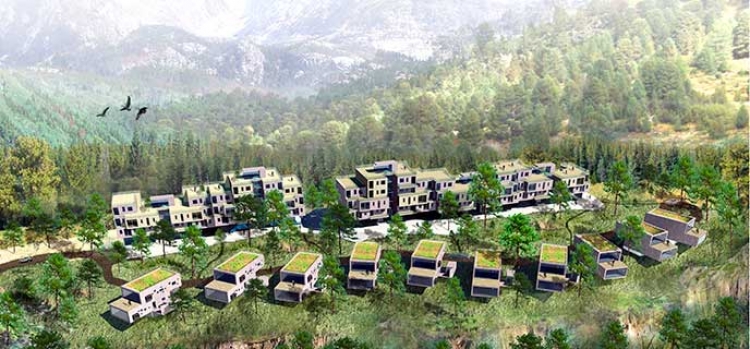
 RESIDENCE IN THREE-D - by Enok Gåsland
RESIDENCE IN THREE-D - by Enok GåslandThe project offers a more articulated, three-dimensional approach to residential architecture. The project combines prefabricated rooms partly enclosed and partly connected by a triangulated timber skeleton that inspires new thinking about the spatial organisation of residential functions. The project explores the architectural potential of resident-adapted mass-production housing based on CNC technology.
DOWNLOAD PROJECT DESCRIPTION HERE (pdf)
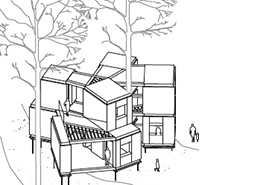 LIFE BETWEEN THE TREES - by Rikke Nyrud and Enya Aamo Aspen
LIFE BETWEEN THE TREES - by Rikke Nyrud and Enya Aamo AspenThe project aims to build a residential project in and around an existing pine forest in the outskirts of Oslo. The project proposes a series of prefabricated volumes that are lifted off the ground and placed in-between existing trees on site. Focus is on area efficiency and adaptability to to the topography and the vegetation on site. Open and generous spaces are generated between the building volumes.
DOWNLOAD PROJECT DESCRIPTION HERE (pdf)
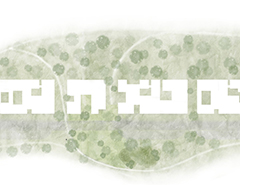 HERE, BUT NO FURTHER - by Mira Wolden and Liv K. Hanstad
HERE, BUT NO FURTHER - by Mira Wolden and Liv K. HanstadThe project proposes a thin band of residences at the border between the city and the surrounding "marka" nature reserve. The project is built with prefabricated CLT walls and slabs. The cladding is charred spruce panels.
DOWNLOAD PROJECT DESCRIPTION HERE (pdf)
 OVER - by Stig Andre Clason and Glenn Alexander Hansen
OVER - by Stig Andre Clason and Glenn Alexander HansenThe project is based on a large L shaped building module that can be positioned in different ways to create a variety of spaces and residences. The whole project is lifted from the ground and supported by and enclosed in a system of timber trusses. The trusses allow for long free spans and flexibility inopen and closed spaces.
DOWNLOAD PROJECT DESCRIPTION HERE (pdf)
To order high resolution of project descriptions:
The above project descriptions have been reduced in size for ease of upload and accessibility. This may in some cases have affected the overall quality and resolution of images or drawings. You can request high resolution copies of the original documents by contacting the WBB using the email wbb@aho.no. Please stipulate the title of desired project and intended purpose and/or use of project material.
Urban timber buildings with mixed functions
AUTUMN 2013
Course description:
Densification in urban centers, in new towns and at transportation nodes requires new development patterns, functional mixes, building typologies and construction processes. New wood technology and solutions for fire protection opens for a broader application of wood-based solutions in urban areas. Stronger focus on the environmental properties and the carbon-sequestrating potential of building materials places wood at the centre of attention. Despite this, we have few examples of new urban wooden quarters of a high architectural quality. A wide variety of possible solutions for two to eight storey buildings may challenge the traditional low-rise and high-rise housing models and urban blocks. Priority of high density and mixed functions at street level may create varied urban qualities. The aim of the course is to develop examples of new urban developments with an optimal mix of functions. The projects shall combine housing, offices, stores, library, kindergarten and other urban functions. The solutions will be developed to a high level of detail. Attention will be given to integration of constructions and other technical systems in architectural designs of a high quality. Group work will be possible. Suitable sites are sought for in Kongshavn, Filipstad and Furuset in Oslo,
Holmen in Asker municipality an Strømsø in Drammen town.
Tutors: Marius Nygaard, Ute Groba, Lars Hamran
Students: Katarina Sæbø Dale, Simon Natanael Korsmoe, Merete Claudi-Tønnessen, Øyvind Anker Ljosland, Daniel Kvalem Oltedal, Stefan Aaberg Landøy, Ketil Andersen, Lars Egge Johnsen, Rita Moholt, Jenny Ueland, Børge Goa, Ona Katrina Flindall, Sigurd Gjesti Berge
External examiner: Henning Kaland, Code: architecture
Selected student projects:
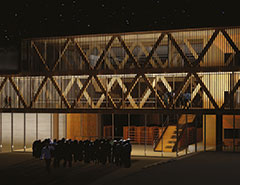 FURUSET - by Børge Goa, Daniel Oltedal, Sigurd Gjesti Berge, Øyvind Anker Ljosland and Simon Korsmoe
FURUSET - by Børge Goa, Daniel Oltedal, Sigurd Gjesti Berge, Øyvind Anker Ljosland and Simon Korsmoe In this new urban quarter in the Furuset suburb a community hall in concrete stabilizes an outer grid of large glulam columns and trusses. This wooden system encloses a library, a youth club, offices and commercial functions. Blocks of flats built in cross-laminated timber are organized around an adjacent courtyard.
DOWNLOAD PROJECT DESCRIPTION HERE (pdf)
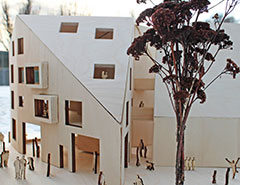 A CITY IN THE CITY - by Ona Findall and Katarina Sæbø Dale
A CITY IN THE CITY - by Ona Findall and Katarina Sæbø Dale
An urban Child and Family Support Hub is integrated in a filter of faceted housing volumes protecting the inner area of Schous square in the Grünerløkka area in Oslo. The buildings are constructed in CLT walls and slabs. The irregular building shapes are accentuated by continuous cladding in steam bent oak.
DOWNLOAD PROJECT DESCRIPTION HERE (pdf) DRIFTWOOD HOTEL - Stefan Aaberg Landøy
DRIFTWOOD HOTEL - Stefan Aaberg Landøy
The hotel is located on the north side of a new "water plaza" in Lohavn harbour. The large, regular and expressive timber structure associates to old quayside warehouses. Concrete stair- and elevator shafts provide lateral stiffness. Movable, glazed oak screens create a facade that responds to varying needs for protection.
DOWNLOAD PROJECT DESCRIPTION HERE (pdf) THE TIMBER WORKS - by Jenny Ueland and Lars Egge Johnsen
THE TIMBER WORKS - by Jenny Ueland and Lars Egge Johnsen
Along the street this timber information center adapts to the scale and rythm of the existing 1890es buildings. Towards the inner square the triangulated glulam skeleton structure meanders downward to enclose an exhibition hall and a covered outdoor space. Spherical joints connect the wooden members.
DOWNLOAD PROJECT DESCRIPTION HERE (pdf)
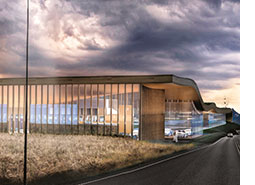 BMW ZERO-ENERGY DEALERSHIP CONCEPT - by Glenn A Hansen, Nils H Henningstad, Arne Sveinsvoll, Stig A Clason and Isaak Bashevkin
BMW ZERO-ENERGY DEALERSHIP CONCEPT - by Glenn A Hansen, Nils H Henningstad, Arne Sveinsvoll, Stig A Clason and Isaak Bashevkin In cooperation with the Bilia car sales and service company the student team developed an all wood pilot project containing exhibiton spaces, offices and workshops. Extensive studies and analyses were carried out to verify a timber based, zero emission strategy.
DOWNLOAD PROJECT DESCRIPTION HERE (pdf)
To order high resolution of project descriptions:
The above project descriptions have been reduced in size for ease of upload and accessibility. This may in some cases have affected the overall quality and resolution of images or drawings. You can request high resolution copies of the original documents by contacting the WBB using the email wbb@aho.no. Please stipulate the title of desired project and intended purpose and/or use of project material.
Diploma projects
In addition to the students that participated in the masters studios, many students chose to continue the study of timber solutions into their diploma projects, acting as a welcome extension to the research project
Tutors: Marius Nygaard, Børre Skodvin, Ute Groba, Catherine Sunter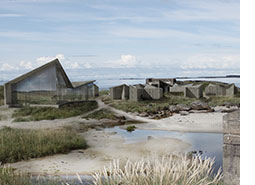 SOLSTRANDEN NORDSJØBAD - by Kama Nybø and Katrine Hamre Sørlie
SOLSTRANDEN NORDSJØBAD - by Kama Nybø and Katrine Hamre Sørlie A landscape café and outdoor bathing facilities at Solastranden near Stavanger at the west coast of Norway. The project reuses abandoned WWll german bunkers in revitalizing the beach zone. Footpaths and small protected places enable the visitors to feel and observe the weather, the ever changing light and the timeless presence of the horizon.
DOWNLOAD PROJECT DESCRIPTION HERE (pdf)
 UNUSED SPACE - by Eline Egeland
UNUSED SPACE - by Eline Egeland The project explores alternative ways of densifying Oslo by taking advantage of small, leftover spaces in the city.The thesis consists of three projects on typical sites containing places where artists can live and work. Prefabricated timber constructions are very well suited for this type of projects. They enable short building periods which minimize disturbances in the urban environment.
DOWNLOAD PROJECT DESCRIPTION HERE (pdf)
 KINN INN - by Eskil Frøyen Nybø and Even Småkasin
KINN INN - by Eskil Frøyen Nybø and Even SmåkasinThe project proposes an inn in the fishing village of Rognaldsvåg in Sogn og Fjordane county. At the quayside the project has placed a reception, restaurant, gallery and service functions for boat tourists. A series of guest rooms are integrated in new buildings in vacant spaces between the existing buildings. Giving visitors the opportunity to experience the landscape and the cultural heritage and the North Sea weather.
DOWNLOAD PROJECT DESCRIPTION HERE (pdf)
 ABOVE OSLO - by Siri Idland
ABOVE OSLO - by Siri IdlandOslo is one of the fastest growing cities in Europe. High-rise densification has been a hot topic in the discussion of urban politics. This diploma project proposes a 23 story timber building with commercial areas in the lower parts, surrounding a new square. The stepped upper structure contains dwellings. All have balconies and terraces overlooking the distant cityscapes and the large Frogner park.
DOWNLOAD PROJECT DESCRIPTION HERE (pdf)
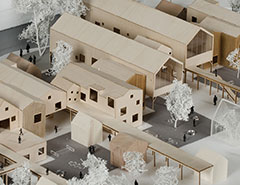 KINDERGARTEN AS URBAN INTERVENTION - by Jonas Østhagen Hamar and Truls Schiefloe Sandbakk
KINDERGARTEN AS URBAN INTERVENTION - by Jonas Østhagen Hamar and Truls Schiefloe SandbakkToday, kindergartens are often situated outside the city centers. Their architecture and associated outdoor spaces are rarely designed to accommodate a variety of uses within or after regular opening hours. This diploma project explores how a kindergarten may contribute to functional and architectural diversity in an urban setting.
DOWNLOAD PROJECT DESCRIPTION HERE (pdf)
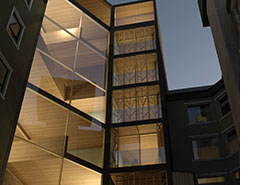 DOWNTOWN TIMBER - by Marte Guldvik, Gro Krüger and Ole Fredrik Kleivene
DOWNTOWN TIMBER - by Marte Guldvik, Gro Krüger and Ole Fredrik KleiveneThe project explores the potential of urban timber structures by redesigning three different types of developments in downtown Oslo: An infill, a superstructure and an urban block. A "Timber Twin" approach was tried out, where existing and well-known buildings were substituted by a timber alternative.
DOWNLOAD PROJECT DESCRIPTION HERE (pdf)
 HARVESTING HAPPINESS - by Mattias Tellqvist and Kristian Vea
HARVESTING HAPPINESS - by Mattias Tellqvist and Kristian VeaThis large-scale urban transformation project is organized around a central, green "spine" with rich vegetation and a areas for intensive urban agrigulture. Several structural systems in timber are explored in the design of new blocks of flats and refurbishments of existing buildings for agricultural, commercial and public functions.
DOWNLOAD PROJECT DESCRIPTION HERE (pdf)
 LAYERS OF TRANSFORMATION WITHIN AN URBAN QUARTER - by Stine Kornmo Janssen
LAYERS OF TRANSFORMATION WITHIN AN URBAN QUARTER - by Stine Kornmo JanssenThe thesis investigates strategies for densification within an urban quarter in the city of Drammen. A lightweight timber residential structure is added to the top of a concrete corner building from 1966 and a new programme (café, workshops and exhibition spaces) is integrated into the existing structure.
DOWNLOAD PROJECT DESCRIPTION HERE (pdf)
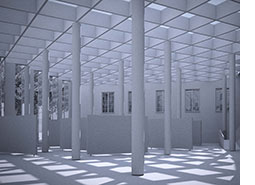 LIBRARY EXTENDED - An addition to Fredrikstad public library - by Haris Ramic
LIBRARY EXTENDED - An addition to Fredrikstad public library - by Haris RamicThe main public library in Fredrikstad, built in 1926, has been characterized as “grand and honourable, but hopelessly un-modern and non-functional”. This diploma project adds a multifunctional access hall and transforms the existing book storage tower into a unique space for study and reading.
DOWNLOAD PROJECT DESCRIPTION HERE (pdf)
 THE VIKING MUSEUM AT BYGDØY - by Shohreh Kheirati and Kamilla Merete Kristiansen
THE VIKING MUSEUM AT BYGDØY - by Shohreh Kheirati and Kamilla Merete Kristiansen The project combines the contrasting characters and structural properties of concrete and timber in creating a museum that captures the whole story of the Viking age and gives a greater focus on the Viking ships. Priority has been given to improved facilities for visitors, exhibitions, and conservationists.
DOWNLOAD PROJECT DESCRIPTION HERE (pdf)
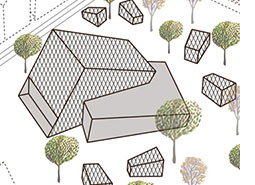 TRADERA - by Katarina Sæbø Dale and Lone Kjersheim
TRADERA - by Katarina Sæbø Dale and Lone Kjersheim ´Tradere´ means oral transfer of traditional knowledge. The Hardanger fiddle tradition is about transfer of knowledge about music and instruments from master to pupil. The central parts of the project are a concert hall and small spaces for outdoor and indoor practice and performance. The design reflects the timber tradition and the acoustic requirements of the users of the buildings.
DOWNLOAD PROJECT DESCRIPTION HERE (pdf)
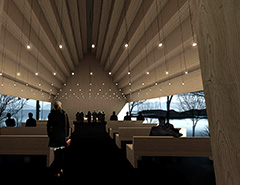 PROMATORIUM - by Magnus Flo
PROMATORIUM - by Magnus Flo
A nondenominational ceremonial funeral space with the necessary technical facilities for ecological burials by promession. The project is set within a memorial garden. The structure is based on a system of CLT gabelwalls and gluelam beams.
DOWNLOAD PROJECT DESCRIPTION HERE (pdf)
To order high resolution of project descriptions:
The above project descriptions have been reduced in size for ease of upload and accessibility. This may in some cases have affected the overall quality and resolution of images or drawings. You can request high resolution copies of the original documents by contacting the WBB using the email wbb@aho.no. Please stipulate the title of desired project and intended purpose and/or use of project material.